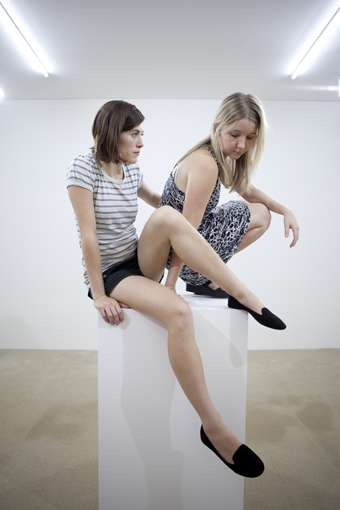The title foregrounds space
Barbara Campbell, Kaldor Public Art Projects, 13 Rooms

Clark Beaumont, Coexisting, 2013, performed by the artists and commissioned by Kaldor Public Art Projects for Kaldor Art Project 27: 13 Rooms
photo Jamie North/Kaldor Public Art Projects
Clark Beaumont, Coexisting, 2013, performed by the artists and commissioned by Kaldor Public Art Projects for Kaldor Art Project 27: 13 Rooms
The title foregrounds space. As Klaus Biesenbach says in the catalogue introduction, not 13 Performances nor 13 Artists, but 13 Rooms and later, when talking about developing the project with Hans Ulrich Obrist, of wandering amongst the sculptures in the Villa Borghese, “we could do a sculpture gallery, one room after the other, but in each room it would be a ‘living sculpture’…” (catalogue).
Obrist takes up the curatorial narrative of wanting the exhibition to occupy time as well as space. So, with terms borrowed both from the visual and performing arts, what conceptions of space and time did 13 Rooms give us?
Sydney-siders like to go to the water to recreate. The wharves and piers closest to the CBD are a story of continuous erasure: in place of canoes, cruise liners; in place of bond stores, Biennales; the site of a bitter waterfront dispute will soon be a casino. The artists of 13 Rooms were not asked to address the history or material properties of Pier 2/3. The space for their work had been determined well before it landed in Sydney, in Manchester as 11 Rooms and in Essen as 12 Rooms. For the Sydney iteration Harry Seidler and Associates—the firm renowned for modernist architecture in Australia—was commissioned to design variations of the classic white cube gallery, one for each artist. Outside the cubes, the audience performed: promenading, catching up, queuing, standing back to watch, chasing after children (or not) and choosing when to effect the next entrance.
As for the selection of artists, most are big names on the international art circuit, though not all derived their reputation from within the field of performance (Hirst and Baldessari, for example, famously extend definitions of painting). The importation of name artists to Sydney is not new—the John Kaldor projects since 1969 and the Sydney Biennales since 1973 provide a lineage of exposure to local audiences of ambitious works from elsewhere. Among the local art community such encounters stir a genuine willingness to engage which, if not well managed, can quickly slide into cynicism or resentment. The Sydney Biennale curators were made to recognise this early on and have included a (usually) good proportion of Australian artists in their selection, thus elevating those artists specifically and the local scene generally to the international stage, and as a side benefit, allowing for natural dialogue to arise between locals and visitors.
The 13 Rooms curators had commissioned works that specifically did not rely on the presence of the artist-authors. ‘Sculpture’ (transportable, transposable, mute) as per Biesenbach’s narrative, was still then the stronger term. The ‘living’ part, it was inferred, could be achieved by alienating certain qualities or qualifications (appearance or physical training, for example) from the subject. For those of us coming out of a whole other history and ethos of performance that embraced the risks of authoring-while-doing, unrepeatability and an assumed contract between performer and audience of doing time together, it was a difficult proposition to swallow.
Of the international works, some came off better than others, depending on the performance strategy applied. Santiago Sierra, for instance, delegated the idea of authenticity to other bodies. His Veterans of the Wars of Afghanistan, Timor-Leste, Iraq and Vietnam Facing the Corner, brutally rejected any thought of entertainment (no movement, no eye-contact) and threw the complexities of moral responsibility back on the observers. Hirst and Ondák leant heavily on and were rewarded by the skilled sociability of their ‘interpreters’ to deliver their work. Delegation of bodily presence over time was more problematic for the two artists who were the inhabitants of their work when originally performed: Marina Abramovi?’s Luminosity of 1997 and Joan Jonas’ Mirror Check of 1970. Both works suffered from their management (warnings, guards, taped off areas, ‘no camera’ signs, constant opening and closing of doors and half-hour shifts for the ‘interpreters’). That the performers were able to hold focus and thus transmit a real sense of live engagement says much for their experience as practitioners in their own right.
Interestingly it was the locals—young Brisbane-based duo Clark Beaumont—who relied on endurance and improvisation for the effectiveness of their work. They were the only authors as performers and the only artists willing to take the 7.5 hours per day opening times (that is, gallery time) as the given duration for their performance. They could not have fulfilled the ‘living sculpture’ brief more closely.
As ephemeral as the works they briefly housed, the 13 Rooms are gone now. Pier 2/3 is still there, waiting to receive its next guests.
Kaldor Public Art Projects, 13 Rooms, curators Hans Ulrich Obrist, Klaus Biesenbach, 11-21 April, Pier 2/3, Walsh Bay, Sydney. Quotations from Hans Ulrich Obrist & Klaus Biesenbach, “Curators in Conversation,” 13 Rooms catalogue, Rushcutters Bay: Kaldor Public Art Projects, 2013.
RealTime issue #115 June-July 2013 pg.






